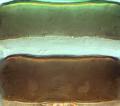Aeolothrips nitidus
Recognition data
Distinguishing features
Both sexes of this species are fully winged and uniformly brown, including antennal segment I–II. However, the succeeding antennal segments are all unusually pale in color, with both III and IV yellow although IV usually has the pedicel almost black. The fore wing has a longitudinal dark band along the posterior margin that extends from the tip of the clavus to the wing apex, although the extent of the shading on the clavus is variable in the available specimens. Sternites IV–VI have the median two pairs of marginal setae arising at the margin, but the lateral two pairs arise well forward on the discal area.
Related and similar species
The fore wing pattern and metanotal sculpture of A. nitidus is similar to that of A. kuwanaii, but the antennal segments are remarkably pale (Bailey, 1951: 63). Just over 90 species are placed currently in the genus Aeolothrips, of which more than 50 are from the Palaearctic Region (mainlyEurope), and 28 from the Nearctic (mainly western USA). Only two species are recorded from the Neotropics; the one from Chile is probably the same as A. fasciatus, and one from Panama is probably not a member of this genus (Mound & Marullo, 1996).
Taxonomic data
Current valid name
Aeolothrips nitidus Moulton
Original name and synonyms
- Aeolothrips nitidus Moulton, 1946: 59
Family placement
Aeolothripidae
Biological data
Life history
Adults and larvae were taken in considerable numbers on flowering Sarcobatus in Inyo Forest, and the species was probably predatory on a small abundant thripid.
Host plants
Breeding on greasewood (Sarcobatus vermiculatus; Chenopodiaceae).
Tospoviruses vectored
None
Crop damage
None
Distribution data
Area of origin
Western USA
Distribution
California, Idaho, Utah.




